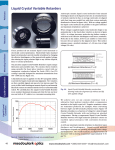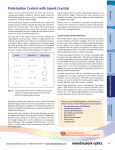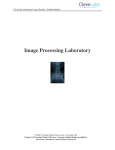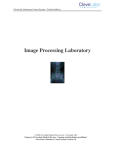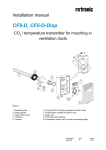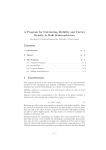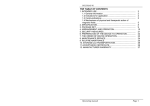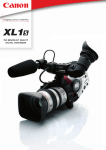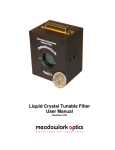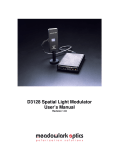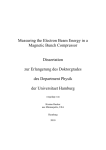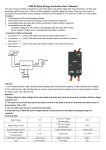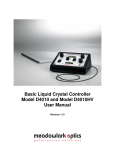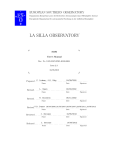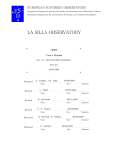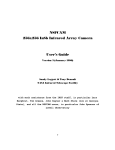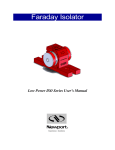Download Liquid Crystal Variable Retarders Twisted
Transcript
Polarizers CUSTOM LIQU ID CRYSTAL CAPABILITIES Liquid Crystal Variable Retarders Retarders A basic building block of Meadowlark Optics’ line of liquid crystal products is the Liquid Crystal Variable Retarder (LCVR). A single one of these devices can replace an entire series of standard crystalline retarders. They are electronically adjustable from nearly 0 waves (or beyond with an optional compensator) to over half wave in the order of 10 milliseconds. An advanced use of LCVRs is described in the application note “Stokes Polarimetry Using Liquid Crystal Retarders”, which is available on our Web site at www.meadowlark.com. While we typically list our standard products as the Liquid Crystal Variable Retarder, Attenuator and Polarization Rotator, we also have the ability to utilize Liquid Crystals in other ways that are extremely useful. The Twisted Nematic Liquid Crystal Device (TN Device) provides our customers with potential for custom applications where a standard LCVR might not be appropriate. The Liquid Crystal Circular Polarizer (LCCP) is one way to achieve isolation with a liquid crystal cell. At Meadowlark Optics we never cease working on polarization solutions for our customers. We hope the information below will provide our customers with new ideas that will challenge us to create new, exciting solutions for polarization control. 0.1 Transmission 0.8 0.04 0.4 0.02 0 2 14 Spatial Light Modulators 4 6 8 10 12 Cell Thickness (arb. units) 0 0 2 4 6 8 10 12 14 U U=2d(/) Fig. 4-1 Transmission by a twisted-nematic cell between parallel polarizers as a function of thickness and/or wavelength. Inset shows cell thickness change only. w e b s i t e : w w w. m e a d o w l a r k . c o m Page 32 Custom • Mounts If the twist is gentle when compared to the wavelength of the light, the polarization will simply follow the twist of the liquid-crystal molecules. Such a cell is said to be operating in the “Mauguin limit” and its rotation is quite achromatic. The polarization rotation angle is equal to the twist angle for all wavelengths, which are short enough for the twist to be viewed as sufficiently gentle. When this is not the case, the cell will no longer act as a pure rotator. The result of inputting linearly polarized light is no longer an output of rotated linearly polarized light, but rotated elliptically polarized light. However, for certain discrete wavelengths, depending on the birefringence of the liquid crystal and the thickness of the cell, the pure rotation characteristic is retained. This is illustrated in figure 4-1, which shows the transmission Polarimeters does not affect the light. At low voltage, however, the twist does affect the light, causing rotation of the polarization. A twisted-nematic liquid-crystal cell is constructed in the same manner as a standard LCVR except the alignment of the liquid-crystal molecules is twisted 90°. As in an LCVR, high voltage (~10V) aligns the molecules with the field and removes the birefringence and therefore Fax (303) 833-4335 0.06 0.6 0 One is often only interested in the ‘s’ and ‘p’ polarization of an optical system, or, in the case of a digital optical switch, only two states are frequently required. If you desire to switch the polarization state between only two angles, for example 0 and 90°, a twisted-nematic device is an excellent solution. A big advantage of the twisted nematic device over an LCVR is the simplicity of the driving scheme. High voltage (above ~10V) gives 0 rotation and low voltage (below ~1V) gives 90° rotation, so you need not concern yourself with exact voltages or tight tolerances. Also, the field of view is wide when compared to an LCVR, because the cell is being used in a situation where the optical axis of the liquid crystal molecules is not at an arbitrary angle to the light but is either parallel or perpendicular to it. • 0.08 0.2 Twisted-Nematic Liquid Crystal Cell Te l ( 3 0 3 ) 8 3 3 - 4 3 3 3 Liquid Crystals 1 Polarizers CUSTOM LIQU ID CRYSTAL CAPABILITIES 105 Contrast Ratio Retarders 104 1000 100 10 1 1510 1520 1530 1540 1550 1560 1570 1580 1590 Wavelength (nm) Liquid Crystals Normally White Contrast Normally Black Contrast Fig.4-2 Contrast of a Twisted-Nematic Liquid-Crystal Cell (normalized to 1), of a 90° twisted nematic cell between parallel polarizers to be a function of the variable, where d is the thickness of the cell, is the birefringence, and is the wavelength. Where the curve first goes to zero is termed the “first minimum” and this position is typically used. The next highest transmission minimum is called the “second minimum” and so on. In this plot, moving along the horizontal axis can be viewed as increasing thickness or decreasing wavelength. One might ask, given the achromaticity of thicker cells “why use the first minimum?” The simple answer is speed. The switching speed of an LC is a strong function of the cell thickness; generally, speed drops quadratically with the thickness. Thus, while a cell operating at a particular wavelength in the first minimum condition might switch in 10 to 50msec, one designed to operate achromatically (for example to transmit <1% between parallel polarizers) over the entire visible range can take several seconds to switch. Figure 4-2 shows the high contrasts of several thousands to one, which can be achieved in practice with these type cells. The curve termed “normally black contrast” was taken between parallel polarizers where low voltage gives a dark state and high voltage yields a bright state. The curve termed “normally white contrast” was taken between perpendicular polarizers where the dark state occurs at high voltage. A liquid-crystal circular polarizer (LCCP) is built much as our standard liquid crystal products but utilizes a cholesteric rather than nematic liquid crystal. These LC molecules are aligned to form a helix whose axis is perpendicular to the optical surfaces. Interference effects cause light with the same wavelength (in the medium) and handedness as the LC molecule’s helix to be reflected. Thus, at their design wavelength, these liquidcrystal cells reflect one circular component of polarization, for example right-handed circularlypolarized light, and transmit the other circular component. An unpolarized or linearly-polarized beam will be divided into two circularly-polarized beams. Because circularly-polarized light changes handedness upon specular reflection, these polarizers perform well as optical isolators. Figure 4-3 shows the performance of a typical device being used as an isolator. Because neither polarization is absorbed, LCCPs can also be used as polarizing mirrors, or in certain situations, as a laser-line polarizing beamsplitter. Compared to a typical circular polarizer, composed of a dichroic polarizer and a quarterwave retarder, an LCCP has significantly better transmission performance. With an LCCP, 95% or more of properly polarized light will be transmitted, compared to 80% or less for a dichroic circular polarizer. Because they are transparent at wavelengths away from their center wavelength, they will easily transmit a probe beam or can be stacked to extend their range. Custom Mounts Polarimeters Spatial Light Modulators U=2d(/), Liquid Crystal Circular Polarizers Page 33 Te l ( 3 0 3 ) 8 3 3 - 4 3 3 3 • Fax (303) 833-4335 • e-mail: [email protected] Retarders When using a liquid-crystal circular polarizer, certain properties should be kept in mind. The center wavelength is a function of temperature. For example, the center wavelength of a device working at 850 nm will drop by roughly 0.5 nm/°C. The operating wavelength is also a weak function of angle. Being an interference phenomena, the center wavelength, c, follows the typical Bragg formula, Polarizers CUSTOM LIQU ID CRYSTAL CAPABILITIES c=ocos(), where o is the center wavelength at normal incidence and is the angle of incidence relative to the normal. Clearly, one must also always remember that both a transmitted and reflected beam exists. Of more subtle concern is the fact that, unlike other reflecting surfaces, the handedness of circularly polarized light does not change upon reflection from an LCCP as it does with an ordinary specularly reflecting surface. Therefore, light passing through an LCCP that becomes right-handed circularly polarized will become left-handed upon reflection and will therefore be rejected when it again reaches the LCCP. This is the basis of their use as isolators. Because it is still left-handed circularly polarized, upon subsequent reflection from an ordinary surface, the rejected beam will be able to pass through the LCCP. The simplest way to protect from these “secondary” reflections is to slightly tip the LCCP so that reflected light is sent out of the optical path into a beam block. 100 60 Liquid Crystals % Transmission 80 40 20 0 0.9 0.95 1 1.05 1.1 Relative Wavelength (Ⲑc) Fig. 4-3 Isolation performance of a LCCP Polarimeters Mounts The performance of these types of liquid crystal devices is established primarily by two factors. The first is related to the “secondary” reflection noted above. Because of this effect, the polarization purity will be degraded by any reflections from the outer glass surface of the cell. Thus a high quality anti-reflective coating is quite important for high isolation. Secondly, there are typically a few nanometers of residual retardance in these cells, which will lower both the circularity and the isolation. This effect becomes most significant at short wavelengths dropping isolations of roughly 99.9% in the near IR to only about 99% towards the blue. Better isolations are possible but these tend to induce a small amount of scattering. Spatial Light Modulators only half integer numbers of pitches within the LC helix. Thus 49.5, 50 or 50.5 helical pitches may fit between glass substrates but not 49.2 or 50.1, etc. Slight irregularities in the thickness cause the LC’s helical pitch to minutely contract or expand until the next allowed number of pitches becomes energetically favorable. At this point, there is an abrupt change in pitch to the opposite extreme. The center wavelength follows the pitch. The two curves in figure 4-3 show the change in optical performance as one crosses or proceeds between one of these pitch disclinations. Again, while they do not significantly affect the performance at the central wavelength, they do cause a narrowing of the useful bandpass. Pitch dislocations are essentially a cosmetic defect, which does not affect the performance of an LCCP at its design wavelength. The surface alignment layer allows Custom Te l ( 3 0 3 ) 8 3 3 - 4 3 3 3 • Fax (303) 833-4335 • w e b s i t e : w w w. m e a d o w l a r k . c o m Page 34 light modulator section for details and specifications on these innovative products. Liquid Crystals Spatial Light Modulators Polarimeters Mounts Custom The long axis of the liquid crystal molecules defines the extraordinary (or slow) index. With no voltage present, the molecules lie parallel to the windows and maximum retardance is obtained. When voltage is applied across the liquid crystal layer, the molecules tip parallel to the applied electric field. As voltage increases, the effective birefringence decreases, causing a reduction in retardance. Custom retardances can be achieved by using high birefringent materials and/or increased liquid crystal layer thickness. Birefringence of liquid crystal materials decreases at longer wavelengths, requiring proper evaluation and design for optimum performance. Meadowlark Optics’ Liquid Crystal Variable Retarders are used throughout the visible and near infrared region. Our liquid crystal retarders are sensitive to temperature and wavelength changes, and can be calibrated to provide high precision tunable retarders, insensitive to temperature or wavelength change. Liquid crystal retarders offer outstanding performance over large incidence angles. Material type, cavity thickness, and especially operating voltage play a large role in determining the acceptable input angle. Phase control or modulation is possible for light linearly polarized parallel to the slow axis. Electrical control of the effective extraordinary index allows precision tuning of an optical phase delay in the propagating beam. Variable attenuators with no mechanical rotation are configured by placing a Liquid Crystal Variable Retarder between crossed polarizers. Full 180° linear polarization rotation can easily be achieved by combining the Liquid Crystal Variable Retarder with a fixed quarter waveplate. Liquid crystal spatial light modulators consist of individually controllable pixels. These devices are used in a variety of intensity and/or phase control applications where spatial variation is required. Refer to the spatial Page 35 Te l ( 3 0 3 ) 8 3 3 - 4 3 3 3 • A Meadowlark Optics’ award-winning Liquid Crystal Variable Retarders provide precise solidstate retardance tunability. These true zero-order IN devices are precision engineered, offering NIN excellent performance in the visible to near infrared wavelength ranges. When combined with other optical components, our Liquid Crystal Variable Retarders produce electrically controllable attenuation, linear polarization rotation, or phase modulation. WAR D Meadowlark Optics’ liquid crystal retarders are constructed using precision polished, optically flat fused silica windows spaced a few microns apart. The cavity is filled with nematic liquid crystal material and sealed. This assembly ensures excellent transmitted wavefront quality and low beam deviation required for many demanding applications. Liquid Crystal Variable Retarders W Retarders L iquid Crystal Variable Retarders are solid state, realtime, continuously tunable waveplates. Nematic liquid crystals are birefringent materials whose effective birefringence can be changed by varying an applied voltage. G Polarizers POLARIZATION CONTROL WITH LIQU ID CRYSTALS Voltage (volts) Retardance V2 = /2 2<V<4 /4 < < /2 V4 = /4 4<V<7 0 < < /4 V7 =0 Output Fig.4-4 Output polarization forms for different retardance values of a compensated variable retarder with horizontal linearly polarized input Continuous tuning of retarders over a broad wavelength range is required for many applications. This added versatility makes real-time polarization conversion possible with a single Liquid Crystal Variable Retarder and electronic controller. Figure 4-4 shows a variety of output polarization forms achieved with a single device. Pure phase modulation is accomplished by aligning the optic axis of the liquid crystal retarder parallel to a linearly polarized input beam. A Liquid Crystal Variable Retarder is the fundamental component used in the following devices and systems. • variable attenuators • polarization rotators • variable beamsplitters • optical compensators • spatial light modulators • polarimeters • non-mechanical shutters • tunable filters • beam steerers Fax (303) 833-4335 • e-mail: [email protected] Polarizers LIQU ID CRYSTAL VARIABLE RETARDERS T Retarders hese products all use nematic liquid crystal materials to electrically control polarization. Meadowlark Optics’ standard liquid crystal products provide tunable retardation by changing the effective birefringence of the material with applied voltage, thus altering the transmitted light to some elliptical polarization form. Percent Transmission 100 80 400 800 1200 ;; ;; 1600 Wavelength (nm) Fig. 4-5 Typical LC Transmission Anisotropic nematic liquid crystal molecules form uniaxial birefringent layers in the liquid crystal cell. An essential feature of nematic material is that, on average, molecules are aligned with their long axes parallel, but with their centers randomly distributed as shown in figure 4-6(a). With no voltage applied, the liquid crystal molecules lie parallel to the glass substrates and maximum retardation is achieved. When voltage is applied, liquid crystal molecules begin to tip perpendicular to the fused silica windows as shown in figure 4-6(b). As voltage increases, molecules tip further causing a reduction in the effective birefringence and hence, retardance. Molecules at the surface, however, are unable to rotate freely because they are pinned at the alignment layer. This surface pinning causes a residual retardance of ~30 nm even at high voltage (20 volts). Fax (303) 833-4335 Spacer LC Molecules (a) Maximum Retardance (V = 0) LC Molecules tipped with applied voltage (b) Minimum Retardance (V >> 0) Fig. 4-6 Liquid Crystal Variable Retarder construction showing molecular alignment (a) without and (b) with applied voltage (drawing not to scale) • w e b s i t e : w w w. m e a d o w l a r k . c o m Custom • ITO Alignment Layer Mounts Te l ( 3 0 3 ) 8 3 3 - 4 3 3 3 ;; ;; Fused Silica Polarimeters As with any birefringent material, retardance is dependent upon thickness and birefringence. Liquid crystal material birefringence depends on operating wavelength, drive voltage, and temperature. The overall retardance of a liquid crystal cell decreases with increasing temperature (approximately -0.4% per C). 90 Spatial Light Modulators We achieve zero (or any custom) retardance with a subtractive fixed polymer retarder, called a compensator, attached to the liquid crystal cell. Negative retardance values are sometimes preferred, for example, when converting between right- and left-circularly polarized states. Figure 4-7 illustrates retardance as a function of voltage for a typical Liquid Crystal Variable Retarder with and without an attached compensator. Placing a compensated Liquid Crystal Variable Retarder between two high extinction polarizers creates an excellent optical attenuator, with convenient electronic control. Liquid Crystals Our precision Liquid Crystal Variable Retarders require unique fabrication and assembly steps. We construct these retarders using optically flat fused silica windows coated with our transparent conductive indium tin oxide (ITO). Our ITO coating is specially designed for maximum transmission from 450-1800 nm. A thin dielectric layer is applied over the ITO and gently rubbed, to provide for liquid crystal molecular alignment. Two windows are then carefully aligned and spaced a few microns apart. The cavity is filled with birefringent nematic liquid crystal material. Electrical contacts are attached and the device is environmentally sealed. We carefully place the Liquid Crystal Variable Retarder in an anodized aluminum housing such that the fast and slow axes are both at 45° relative to a convenient mounting hole. Page 36 Polarizers LIQU ID CRYSTAL VARIABLE RETARDERS (a) Retarders Retardance (waves) 0.75 momentarily removed to allow the liquid crystal molecules to undergo natural relaxation. Response time achieved with the transient nematic effect is also shown in figure 4-8. Our programmable D3040 Controller described on page 45 can provide the necessary TNE voltage profiles. 0.50 0.25 0 5 10 15 20 15 20 Our standard Liquid Crystal Variable Retarders provide a minimum retardance range of ~30 nm to at least halfwave at the specified wavelength. With an attached compensator, retardance is guaranteed from zero to at least half-wave at the specified wavelength. Custom retardance ranges (up to a few waves) and custom compensators are available. Contact our Sales Department to discuss your requirements. Voltage (volts rms) (b) Liquid Crystals Retardance (waves) 0.75 0.50 0.25 0.00 0 5 10 Voltage (volts rms) Polarimeters Mounts Custom AP ICATIO PL Response Time Liquid Crystal Variable Retarder response time depends on several parameters, including layer NO E thickness, viscosity, temperature, variations in T drive voltage, and surface treatment. Liquid crystal response time is proportional to the square of the layer thickness and therefore, the square of the total retardance. Liquid crystal devices should be electrically driven with an AC waveform with no DC component to prevent N Spatial Light Modulators Fig. 4-7 Liquid Crystal Variable Retarder performance at 632.8 nm, 21 °C (a) without compensator, and (b) with compensator Each Liquid Crystal Variable Retarder is supplied with retardance versus voltage performance data for your specified wavelength. A coaxial cable with BNC connector is provided for easy attachment to an electronic controller. Response time also depends upon direction of the retardance change. If the retardance increases, response time is determined solely by mechanical relaxation of the molecules. If retardance decreases in value, response time is much faster due to the increased electric field across the liquid crystal layer. Typical response time for our standard visible Liquid Crystal Variable Retarder is shown in figure 4-8. It takes about 5 ms to switch from one-half to zero waves (low to high voltage) and about 20 ms to switch from zero to one-half wave (high to low voltage). Response time improves by using custom materials with high birefringence and a thinner liquid crystal layer. At higher temperature, material viscosity decreases, also contributing to a faster response. Another technique involves the Transient Nematic Effect (TNE) to improve response times. With this drive method, a high voltage spike is applied to accelerate the molecular alignment parallel to the applied field. Voltage is then reduced to achieve the desired retardance. When switching from low to high retardance all voltage is Page 37 Te l ( 3 0 3 ) 8 3 3 - 4 3 3 3 • (a) Applied voltage to LC Variable Retarder 90% 4 ms 10% 22 ms 0% t1 t2 (b) Typical temporal response for halfwave operation at 632.8 nm (21C) t3 t4 90% (c) Improved temporal response using Transient Nematic Effect 10% 0% Fig. 4-8 Temporal response of LC Variable Retarder “The temporal response of a liquid-crystal device seems very complicated. Where can I find some clarification?” PROBLEM SOLUTION See our application note on temporal response of liquid crystal devices at www.meadowlark.com. Fax (303) 833-4335 • e-mail: [email protected] ionic buildup which can damage the liquid crystal layer. S PECIFICATIONS Retarder Material: Nematic liquid crystal Substrate Material: Optical quality synthetic fused silica Wavelength Range: 450-1800 nm (specify) Retardance Range: Without compensator: With compensator: A temperature sensing and control option can be added to our Liquid Crystal Variable Retarders for accurate controlling of the operating temperature. The sensor is attached directly to a fused silica substrate outside the Retardance Uniformity: 1.230 0.375 0.275 8-32 TAP All dimensions in inches Model LVR-100 Fig. 4-9 Model LVR-100 dimensions /4 Surface Quality: 40-20 scratch and dig Beam Deviation: 2 arc min Reflectance (per surface): 0.5% Diameter Tolerance: ±0.005 in. Temperature Range: see page 46 Spatial Light Modulators F 2% rms variation over clear aperture Transmitted Wavefront Distortion (at 632.8 nm): Recommended Safe Operating Limit: D 30 nm to /2 wave 0 to /2 wave custom ranges are available Liquid Crystals Meadowlark Optics Retarders We require a 2 kHz square wave of adjustable amplitude for controlling our Liquid Crystal Variable Retarders (LCVR). Either our Model B1020 or D3040 Controller described on pages 44-45, will ensure this requirement is met. 1.000 500 W/cm2 CW 300 mJ/cm2 10 ns, visible S C.A. SMB connector Polarizers LIQU ID CRYSTAL VARIABLE RETARDERS All dimensions in inches O RDERING I NFORMATION t 0.500 8-32 TAP Fig. 4-10 Models LVR-200 and LVR-300 dimensions PROBLEM SOLUTION “I need to measure the polarization state of light. Can I use the retardance tunability of your LCVR to do this?” Absolutely! See our application note on Stokes polarimetry at www.meadowlark.com. ■ ■ 0.70 0.75 LVR - 200 3.00 1.60 1.00 LVR - 300 With Attached Compensator (0 to /2 wave) 1.00 0.37 1.23 LRC - 100 2.00 0.70 0.75 LRC - 200 3.00 1.60 1.00 LRC - 300 • w e b s i t e : w w w. m e a d o w l a r k . c o m Page 38 Custom Fax (303) 833-4335 2.00 * A temperature sensing and control option for series ‘200’ and ‘300’ is available. Please be sure to append “-TSC” to the part number when ordering. For custom retardance ranges or special compensator values, please call for a free quotation. Please contact our sales department to obtain a price list for our standard components. • LVR - 100 Temperature Sensing and Control Option* We offer standard liquid crystal variable retarders to cover 4 regions of the spectrum: VIS: 400 - 700nm IR 1: 650 - 950nm IR 2: 900 - 1250nm IR 3: 1200 - 1700nm Please specify wavelength region when placing your order. Performance from 450 to 1800 nm Computer control capability Temperature control options Unequaled measurement accuracy Te l ( 3 0 3 ) 8 3 3 - 4 3 3 3 Part Number Mounts ■ Thickness t (in.) Without Compensator (30 nm to /2 wave) 1.00 0.37 1.23 K EY B ENEFITS ■ Clear Aperture (in.) Polarimeters Diameter D (in.) Maximum transmission is dependent upon properties of the Liquid Crystal Variable Retarder as well as the polarizers used in your system. An unpolarized light source is used for illumination. Linear Polarized Output f Mounts Polarimeters Entrance Polarizer 45˚ s Compensated Liquid Crystal Variable Retarder Exit Polarizer 60 40 20 0 2 6 4 8 10 Voltage (volts rms) Fig. 4-11 Standard Liquid Crystal Variable Attenuator design uses crossed linear polarizers. With crossed polarizers, light transmission is maximized by applying the correct voltage to achieve half-wave retardance from the liquid crystal cell as shown in figure 4-11. Half-wave operation rotates the incoming polarization direction by 90°, so that light is passed by the second polarizer. Minimum transmission is obtained with the retarder operating at zero (or a whole number of) waves. Transmission decreases as the applied AC voltage amplitude increases (half- to zero-waves retardance). The relationship between transmittance T and retardance (in degrees) for crossed polarizer configuration is given by: T() = 1/2 [1 - cos()] Tmax Custom 80 Fig.4-12 Normalized transmittance of Liquid Crystal Variable Attenuator with crossed linear polarizers at a single wavelength 40 Percent Transmittance Unpolarized Input 100 (normalized to Tmax) eadowlark Optics’ Liquid Crystal Variable Attenuator offers real-time, continuous control of light intensity. Our attenuator consists of a Liquid Crystal Variable Retarder (with attached compensator) operating between crossed linear polarizers. Contrast ratio is defined as the maximum transmission (obtained with the liquid crystal cell at half-wave operation) divided by the minimum transmission (obtained with the liquid crystal cell at zero waves). Values exceeding 1000:1 (see figure 4-14) can be obtained for a single wavelength by optimizing the applied voltage levels for minimum and maximum transmission. We guarantee a minimum contrast ratio of 500:1 at your specified wavelength. Percent Transmittance M Spatial Light Modulators Liquid Crystals Retarders Polarizers LIQU ID CRYSTAL VARIABLE ATTENUATOR 30 20 10 400 500 600 700 800 Wavelength (nm) Fig. 4-13 Transmittance as a function of wavelength for Liquid Crystal Variable Attenuator, optimized for 550 nm, with polarizers and unpolarized input where Tmax is the maximum transmittance when retardance is exactly one-half wave (or 180). Page 39 Te l ( 3 0 3 ) 8 3 3 - 4 3 3 3 • Fax (303) 833-4335 • e-mail: [email protected] A ■ ■ Continuous control of light intensity Computer control capability High contrast ratio S PECIFICATIONS Nematic liquid crystal with Birefringent polymer Polarizer Material: Dichroic polymer Substrate Material: Optical quality synthetic fused silica Custom devices for near infrared applications, utilizing appropriate dichroic polarizers, can also be manufactured. Please see the section on Polarizers for a selection of available polarizers. Model B1020 and D3040 controllers listed on pages 4445 offer the precision necessary to obtain accurate and repeatable intensity control for your application. Contrast Ratio: ≥ 500:1 at single wavelength, 1mm beam Transmittance: 30% with unpolarized input 4 Transmitted Wavefront Distortion (at 632.8 nm): /4 (each component) 3 Surface Quality: ≤ 40-20 scratch and dig Beam Deviation: ≤ 2 arc min Reflectance (per surface): 0.5% at normal incidence Diameter Tolerance: ±0.005 in. Temperature Range: 10 °C to 50 °C 2 1 400 500 600 700 800 Wavelength (nm) Fig. 4-14 Typical Contrast Ratio of a Liquid Crystal Variable Attenuator optimized at 550 nm 1 W/cm2 CW (with dichroic polarizers) Polarimeters Recommended Safe Operating Limit: Log (Contrast Ratio) 450-700 and 900-1550 nm Spatial Light Modulators Wavelength Region: Liquid Crystals Retarder Material: Retarders Liquid Crystal Variable Attenuator can be configured with high efficiency calcite or beamsplitting polarizers to maximize light transmittance and increase damage threshold. With a linearly polarized input beam and a calcite polarizer, transmittance values exceed 90% at most wavelengths. Very high contrast ratios, in excess of 5000:1, can be achieved with custom double attenuators. In this design, two Liquid Crystal Variable Retarders are combined with three polarizers. K EY B ENEFITS ■ Polarizers LIQU ID CRYSTAL VARIABLE ATTENUATOR O RDERING I NFORMATION Clear Aperture (in.) Part Number 1.00 0.37 LVA - 100 - 2.00 0.70 LVA - 200 - 3.00 1.60 LVA - 300 - Mounts Diameter D (in.) Please specify your operating wavelength in nanometers when ordering. Custom Custom sizes of our Liquid Crystal Variable Attenuators are available. Call for a quote. Please contact our sales department to obtain a price list for our standard components. Te l ( 3 0 3 ) 8 3 3 - 4 3 3 3 • Fax (303) 833-4335 • w e b s i t e : w w w. m e a d o w l a r k . c o m Page 40 A quarter-wave retarder converts elliptical polarization formed by the Liquid Crystal Variable Retarder to linear polarization. The rotation angle is equal to onehalf the retardance change from the Liquid Crystal Variable Retarder. Response time depends upon the desired amount of rotation. Small rotations have longer response times. Polarization purity is defined as the ratio of the rotated linear component to the orthogonal component. A selected rotation is very sensitive to applied voltage and operating temperature. On average, polarization purity, or contrast ratio is better than 150:1. O ur Liquid Crystal Polarization Rotator continuously rotates the polarized direction of a monochromatic, linearly polarized input beam. Our design consists of a Liquid Crystal Variable Retarder combined with a zeroorder polymer quarter-wave retarder. The fast axis of one retarder is oriented at 45 to the slow axis of the second. Linearly polarized input must be parallel to the quarterwave retarder slow axis. Polarization rotation is achieved by electrically controlling the retardance of the Liquid Crystal Variable Retarder, eliminating any mechanical motion. We provide test data including the required voltages corresponding to polarization orientations from approximately -40° to approximately 140° rotation in 10° increments. These measurements are taken at room temperature for your specified wavelength. Standard Liquid Crystal Polarization Rotators are supplied without an input polarizer. Input polarization direction must be precisely aligned for optimum performance. Please call if you require an input polarizer. Input Polarization Polarimeters Spatial Light Modulators Liquid Crystals Retarders Polarizers LIQU ID CRYSTAL POLARIZATION ROTATOR s f Compensated LC Variable Retarder Mounts Rotated Output Polarization s f 4 Retarder Custom Fig.4-15 Operation of Liquid Crystal Polarization Rotator showing complete rotation of a linearly polarized input beam Page 41 Te l ( 3 0 3 ) 8 3 3 - 4 3 3 3 • Fax (303) 833-4335 • e-mail: [email protected] K EY B ENEFITS ■ ■ ■ ■ O RDERING I NFORMATION Continuous rotation of linearly polarized light Computer control capability High polarization purity 180 degree polarization rotation High power capability Nematic liquid crystal with Birefringent polymer Part Number 1.00 0.37 1.23 LPR - 100 - 2.00 0.70 0.79 LPR - 200 - 3.00 1.60 1.00 LPR - 300 - Custom sizes of our Liquid Crystal Polarization Rotators are available. Call for a quote. Optical quality synthetic fused silica Polarization Rotation: 0-180 Polarization Purity: 150:1 average Transmittance: 92% with polarized input Transmitted Wavefront Distortion (at 632.8 nm): /4 Surface Quality: 40-20 scratch and dig Beam Deviation: 2 arc min Reflectance (per surface): 0.5% at normal incidence Diameter Tolerance: ±0.005 in. Temperature Range: 10 °C to 50 °C Polarimeters 450-1800 nm (specify) Please contact our sales department to obtain a price list for our standard components. Spatial Light Modulators Wavelength: Recommended Safe Operating Limit: Thickness t (in.) Liquid Crystals Substrate Material: Clear Aperture (in.) Please specify your operating wavelength in nanometers when ordering. S PECIFICATIONS Retarder Material: Diameter D (in.) Retarders ■ Polarizers LIQU ID CRYSTAL POLARIZATION ROTATOR 500 W/cm2 CW 300 mJ/cm2 10 ns, visible Mounts Custom Te l ( 3 0 3 ) 8 3 3 - 4 3 3 3 • Fax (303) 833-4335 • w e b s i t e : w w w. m e a d o w l a r k . c o m Page 42 Polarizers Retarders BASIC LIQU ID CRYSTAL CONTROLLER O ur basic controller, Model B1020 is specially designed to integrate with any single Meadowlark Optics liquid crystal device described in this section. Manual adjustment of the voltage amplitude controls liquid crystal retardance. Figure 4-7 on page 38 illustrates the relationship between voltage and retardance. Independent voltage settings allow easy and repeatable selection of two retardance values. Often, it is desirable to modulate between the two states. For example, switching between 1/4 wave and 3/4 wave retardance changes linearly polarized light to either right or left circular. A manual toggle allows easy switching between states. Our Model B1020 comes equipped with its own internal modulation control. The dial adjusts regular switching frequency between the two voltage settings. An external input allows liquid crystal retardance modulation to run synchronously with other equipment. Each Meadowlark Optics’ Liquid Crystal Variable Retarder is supplied with a plot of retardance versus voltage. Using a true RMS voltmeter with your Model B1020 Controller and the retardance plot ensures accurate retardance to voltage correlation. An optional Voltmeter Adapter Cable simultaneously connects a liquid crystal device and digital voltmeter to the Model B1020 Controller. NOTE: Previous generations of Meadowlark LC Controllers used BNC to SMB cables. Adapters and replacement cables are available. Please contact Meadowlark for more information. Custom Mounts Polarimeters Spatial Light Modulators Liquid Crystals Fig. 4-16 Front panel layout for Model B1020 Controller Page 43 Te l ( 3 0 3 ) 8 3 3 - 4 3 3 3 • OUTPUT O N EXTERNAL MODULATION O F F Fig. 4-17 Rear panel layout for Model B1020 Controller S PECIFICATIONS Output Voltage: 2 kHz AC square wave adjustable 0-25 V rms 50% duty cycle minimal DC bias Voltage Resolution: 3 mV Internal Modulation: 0.5-150 Hz External Modulation: TTL compatible input 12 V maximum DC-1 kHz Power Requirements: 115/230 VAC 50/60 Hz 5W Dimensions (L x W x H): 7.0 x 5.0 x 3.1 in. Weight: 2.0 lbs O RDERING I NFORMATION Part Number Item Basic Liquid Crystal Controller B1020 Voltmeter Adapter Cable B1020-VAC BNC to SMB adapter BNC-SMB Please contact our sales department to obtain a price list for our standard components. Fax (303) 833-4335 • e-mail: [email protected] Polarizers D3040 QUAD CELL LIQU ID CRYSTAL DIGITAL INTERFACE T Retarders he D3040 Quad Cell Liquid Crystal Interface is designed for ease of use and high precision control of up to four Meadowlark nematic liquid crystal devices at one time. The D3040 controller is available in either Basic or Advanced Package options. The D3040 comes standard with CellDRIVE 3000 Basic software to allow for independent control of the amplitude of the 2-kHz square wave drive for four separate nematic liquid crystal cells. The Advanced Package includes all the functionality of the Basic Package plus the added features of the CellDRIVE 3000 Advanced software and capability for temperature monitoring and control on one channel. The CellDRIVE 3000 Advanced software allows for modulation of the amplitude of the 2-kHz square wave drive using specific functions incusing sinusoidal, square, triangle, sawtooth, and transient nematic effect waveforms. D3040 Features Liquid Crystals • USB or RS-232 PC to Controller Unit Interface • Includes National Instruments LabView™ Virtual Instrument drivers to interface with custom software • Independent control of voltage levels on 4 channels to 1 mV resolution • Compact and simple to use • Microsoft® HyperTerminal configuration file included Spatial Light Modulators Polarimeters CellDRIVE 3000 Basic provides timeinvariant amplitude control of Liquid Crystal Variable Retarders connected to the D3040. Mounts The D3040 Advanced Package includes the functionality of the Basic Package plus temperature control on one channel and CellDRIVE 3000 Advanced software. CellDRIVE 3000 Advanced software is designed to meet the requirements of most LCVR applications. It provides the capability to select and configure a variety of waveforms, including transient nematic effect waveforms, for each output channel. Custom Te l ( 3 0 3 ) 8 3 3 - 4 3 3 3 • Fax (303) 833-4335 • w e b s i t e : w w w. m e a d o w l a r k . c o m Page 44 Polarizers D3040 QUAD CELL LIQU ID CRYSTAL DIGITAL INTERFACE Spatial Light Modulators Liquid Crystals Retarders Basic package includes: S PECIFICATIONS • D3040 Controller Unit • Power supply and power cable • USB and RS232 cables • CellDRIVE 3000 Basic software • National Instruments™ LabVIEW™ virtual instruments driver • D3040 User’s Manual Fundamental Drive Waveform: 2-kHz square wave Modulation Amplitude: 0 to 10 Vrms Modulation Resolution: 1 mV (0.155 mV using Lab VIEW subroutines) DC Offset: < 5 mV Advanced package includes: LC cell to Controller Connection: PC-Controller Communications Interface: USB or RS232 • D3040 Controller Unit • Power supply and power cable • USB and RS232 cables • LC-Controller interface cable • Temperature control cable • CellDRIVE 3000 Advanced software • National Instruments™ LabVIEW™ virtual instruments driver • Temperature monitoring and control • D3040 User’s Manual with TSC option may not be compatible with the TSC option in the D3040. NOTE: Previous generations of Meadowlark LC Controllers used BNC to SMB cables. Adapters and replacement cables are available. Please contact Meadowlark for more information. Mounts Polarimeters Power Requirements: 100-240 VAC, 47-63 Hz, 500 mA Safety and Environmental Certification: CE compliant External Dimensions: 9.5" x 6.25" x 1.5" Weight: <2 lbs. Advanced Package only Modulation Waveforms: NOTE: Previous generations of Meadowlark LC devices SMA-SMB connectors, 2m length Temperature Control: sinusoidal triangle square sawtooth transient nematic effect Closed-looped feedback controlled active heating/passive cooling ± 1°C of setpoint (nominal) Minimum System Requirements: • Windows® 98/ME/2000/XP • PC with Pentium II class processor • 32 MB RAM • 6 MB hard drive space • CD ROM drive • USB or RS232 COM Port • Use of LabVIEW™ Instrument Library requires LabVIEW™ version 6.1 or newer full development system O RDERING I NFORMATION D3040-BASIC Advanced D3040-ADV Extra SMA-SMB Cables SMA-SMB Custom Basic Page 45 Te l ( 3 0 3 ) 8 3 3 - 4 3 3 3 • Fax (303) 833-4335 • e-mail: [email protected]














